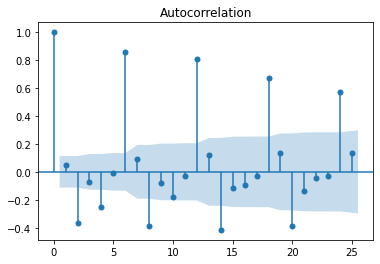This notebook generates time series data in different ways: without regression, with regression.
#from timeseries_generator import LinearTrend, Generator, WhiteNoise, RandomFeatureFactor
#import pandas as pd
#%matplotlib inline
import pandas as pd
from pandas._libs.tslibs.timestamps import Timestamp
import matplotlib.pyplot as plt
from statsmodels.graphics.tsaplots import plot_acf, plot_pacf
# prevents plots from being displayed twice (unique to Jupyter Notebooks)
%matplotlib inline
Setting up parameters (this model doesn’t support regression, see further below for regressive parameters)
# The python package "timeseries_generator" implements day-increment granularity.
# The columns will have to be manually
start_date = Timestamp("01-01-2020")
end_date = Timestamp("01-01-2021")
features_dict = {
"station": ["station_1", "station_2"],
"product": ["bikes"]
}
linear_trend = LinearTrend(coef=1.0, offset=1., col_name="my_linear_trend")
white_noise = WhiteNoise(stdev_factor=0.05)
seasonality = SinusoidalFactor(
feature="product",
col_name="product_seasonal_trend_factor",
feature_values={
"bikes": {
"wavelength": 365.,
"amplitude": 0.2,
"phase": 365/4,
"mean": 1.
}
}
)
weekday_factor = WeekdayFactor(
col_name="weekend_boost_factor",
factor_values={4: 1.15, 5: 1.3, 6: 1.3} # Here we assign a factor of 1.15 to Friday, and 1.3 to Sat/Sun
)
# Plotting the parameters
linear_trend.plot(start_date=start_date, end_date=end_date)
white_noise.plot(start_date=start_date, end_date=end_date)
seasonality.plot(start_date=start_date, end_date=end_date)
weekday_factor.plot(start_date=start_date, end_date=end_date) # Using a smaller timerange here to keep the plot viewable
(<Figure size 432x288 with 1 Axes>, <AxesSubplot:xlabel='date'>)
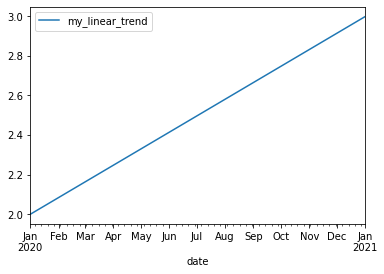

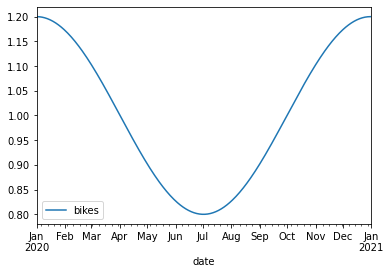
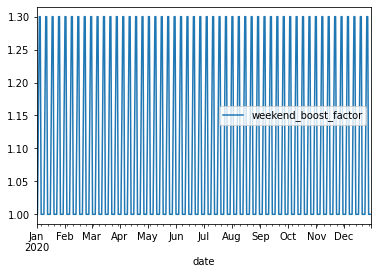
Creating generator
g: Generator = Generator(
factors={
linear_trend,
seasonality,
white_noise,
#weekday_factor,
},
features=features_dict,
date_range=pd.date_range(start=start_date, end=end_date),
base_value=10
)
df = g.generate()
plot_df = df.set_index('date')
plot_df[['station', 'product', 'value']].pivot(columns=['station', 'product'], values='value').plot(figsize=(24,8))
<AxesSubplot:xlabel='date'>
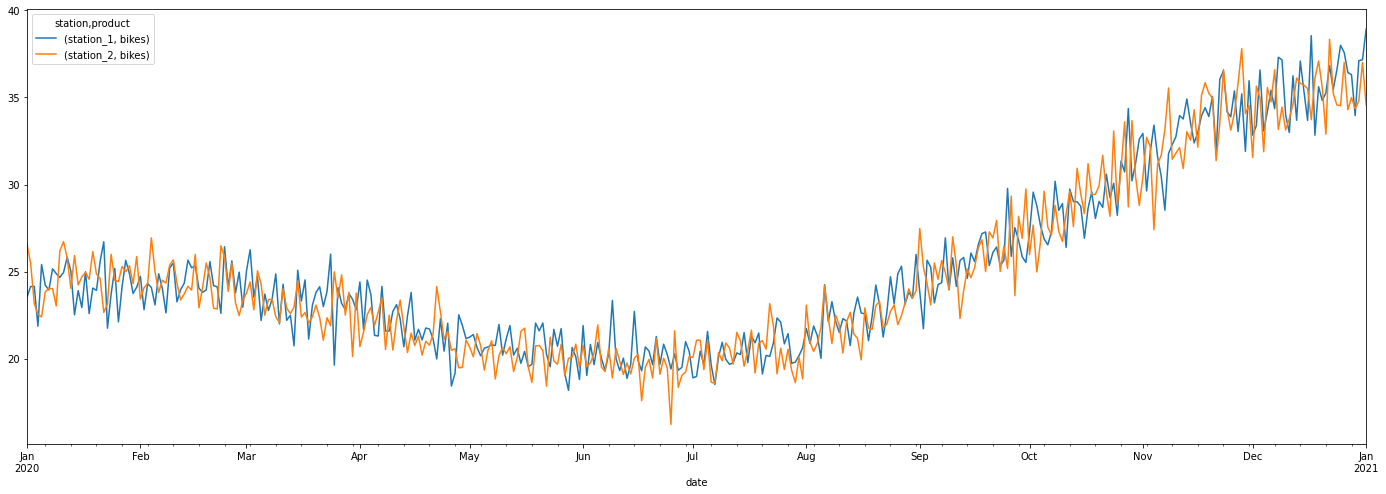
df.head()
| date | station | product | base_amount | my_linear_trend | white_noise | product_seasonal_trend_factor | total_factor | value | |
|---|---|---|---|---|---|---|---|---|---|
| 0 | 2020-01-01 | station_1 | bikes | 10 | 2.000000 | 0.980812 | 1.200000 | 2.353949 | 23.539495 |
| 1 | 2020-01-01 | station_2 | bikes | 10 | 2.000000 | 1.108409 | 1.200000 | 2.660181 | 26.601807 |
| 2 | 2020-01-02 | station_1 | bikes | 10 | 2.002725 | 1.004462 | 1.199970 | 2.413933 | 24.139328 |
| 3 | 2020-01-02 | station_2 | bikes | 10 | 2.002725 | 1.060304 | 1.199970 | 2.548133 | 25.481326 |
| 4 | 2020-01-03 | station_1 | bikes | 10 | 2.005450 | 1.003800 | 1.199881 | 2.415447 | 24.154468 |
AR Fitting (with the above non-regressive time series)
import math
from statsmodels.tsa.seasonal import seasonal_decompose
from pmdarima import auto_arima
from statsmodels.graphics.tsaplots import plot_pacf
from statsmodels.graphics.tsaplots import plot_acf
First, visualize the decomposition and ACF
series = df.copy()
# filtering out the other stations.
series = series[series["station"] == "station_1"]
# make first column a datetime format
series.index = pd.to_datetime(series.date)
# filter out factors "collapses the columns" into a value
series = series['value']
series.head()
decomp = seasonal_decompose(series, model='multiplicative')
# assign each plot it to a variable so the plot doesn't display twice
decomp_plot = decomp.plot()
pacf = plot_pacf(series)
acf = plot_acf(series)
/home/andrew/.local/lib/python3.10/site-packages/statsmodels/graphics/tsaplots.py:348: FutureWarning: The default method 'yw' can produce PACF values outside of the [-1,1] interval. After 0.13, the default will change tounadjusted Yule-Walker ('ywm'). You can use this method now by setting method='ywm'.
warnings.warn(
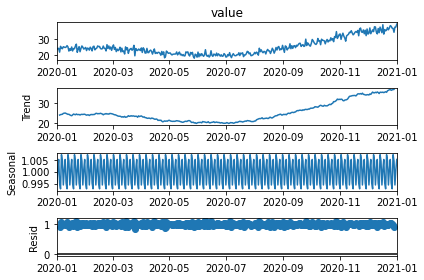


Attempt to fit the data
train = series.iloc[:math.floor(series.shape[0] * 0.8)]
test = series.iloc[math.ceil(series.shape[0] * 0.8):]
print("Shape of train is: ", train.shape)
print("Shape of test is: ", test.shape)
Shape of train is: (293,)
Shape of test is: (73,)
stepwise_model = auto_arima(series, start_p=1, start_q=1,
max_p=3, max_q=3, m=12,
start_P=0, seasonal=True,
d=1, D=1, trace=True,
error_action='ignore',
suppress_warnings=True,
stepwise=True)
print(stepwise_model.aic())
Performing stepwise search to minimize aic
ARIMA(1,1,1)(0,1,1)[12] : AIC=1250.022, Time=1.41 sec
ARIMA(0,1,0)(0,1,0)[12] : AIC=1682.718, Time=0.06 sec
ARIMA(1,1,0)(1,1,0)[12] : AIC=1465.156, Time=0.32 sec
ARIMA(0,1,1)(0,1,1)[12] : AIC=1252.361, Time=0.98 sec
ARIMA(1,1,1)(0,1,0)[12] : AIC=1427.963, Time=0.18 sec
ARIMA(1,1,1)(1,1,1)[12] : AIC=1251.318, Time=2.03 sec
ARIMA(1,1,1)(0,1,2)[12] : AIC=1251.360, Time=4.13 sec
ARIMA(1,1,1)(1,1,0)[12] : AIC=1325.945, Time=0.70 sec
ARIMA(1,1,1)(1,1,2)[12] : AIC=1252.848, Time=6.38 sec
ARIMA(1,1,0)(0,1,1)[12] : AIC=inf, Time=1.99 sec
ARIMA(2,1,1)(0,1,1)[12] : AIC=1249.248, Time=1.80 sec
ARIMA(2,1,1)(0,1,0)[12] : AIC=1427.136, Time=0.21 sec
ARIMA(2,1,1)(1,1,1)[12] : AIC=1250.725, Time=2.18 sec
ARIMA(2,1,1)(0,1,2)[12] : AIC=1250.761, Time=3.95 sec
ARIMA(2,1,1)(1,1,0)[12] : AIC=1324.976, Time=0.81 sec
ARIMA(2,1,1)(1,1,2)[12] : AIC=1252.085, Time=7.62 sec
ARIMA(2,1,0)(0,1,1)[12] : AIC=inf, Time=2.72 sec
ARIMA(3,1,1)(0,1,1)[12] : AIC=1249.583, Time=2.44 sec
ARIMA(2,1,2)(0,1,1)[12] : AIC=inf, Time=6.51 sec
ARIMA(1,1,2)(0,1,1)[12] : AIC=inf, Time=6.86 sec
ARIMA(3,1,0)(0,1,1)[12] : AIC=inf, Time=2.30 sec
ARIMA(3,1,2)(0,1,1)[12] : AIC=inf, Time=8.83 sec
ARIMA(2,1,1)(0,1,1)[12] intercept : AIC=inf, Time=9.74 sec
Best model: ARIMA(2,1,1)(0,1,1)[12]
Total fit time: 74.181 seconds
1249.2477470325662
Using ARMA-simulator to create regressive time series.
First define the class generator
# Source: https://github.com/igarizio/ARMA-simulator
import numpy as np
class ARMA:
"""Class that generates WN, AR, MA and ARMA processes."""
@staticmethod
def generate_wn(n, sigma=1):
"""Generates a white noise series.
The code follows:
y_{t} = \epsilon_{t}
Args:
n: length of the series.
sigma: standard deviation of the innovations.
Returns:
np.Array with the series.
"""
return np.random.normal(0, sigma, size=n)
@staticmethod
def generate_ma(n, thetas, mu, sigma=1):
"""Generates a moving average series.
The code follows:
y_{t} = \mu + \epsilon_{t} + \theta_{1}\epsilon_{t-1} + \theta_{2}\epsilon_{t-2} + ... + \theta_{q}\epsilon_{t-q}
Args:
n: length of the series.
thetas: list of thetas, in the order \theta_{1}, \theta_{2}, ..., \theta_{q}.
mu: base constant.
sigma: standard deviation of the innovations (optional).
Returns:
np.Array with the series.
"""
q = len(thetas)
adj_n = n + q # We add q values because at the beginning we have no thetas available.
e_series = ARMA.generate_wn(adj_n, sigma) # Generating a white noise.
ma = []
for i in range(1, adj_n):
visible_thetas = thetas[0:min(q, i)] # At first, we only "see" some of the thetas.
visible_e_series = e_series[i - min(q, i):i] # The same happens to the white noise.
reversed_thetas = visible_thetas[::-1]
try: # Getting e_t if we can.
e_t = visible_e_series[-1]
except IndexError:
e_t = 0
# Main equation.
ma_t = mu + e_t + np.dot(reversed_thetas, visible_e_series)
ma.append(ma_t)
ma = ma[max(q-1, 0):] # Dropping the first values that did not use all the thetas.
return ma
@staticmethod
def generate_ar(n, phis, sigma=1):
"""Generates an autoregressive series.
The code follows:
y_{t} = \phi_{1} y_{t-1} + \phi_{2} y_{t-2} + ... + \phi_{p} y_{t-p} + \epsilon_{t}
Args:
n: length of the series.
phis: list of thetas, in the order \phi_{1}, \phi_{2}, ..., \phi_{p}.
sigma: standard deviation of the innovations (optional).
Returns:
np.Array with the series.
"""
p = len(phis)
adj_n = n + p # We add q values because at the beginning we have no phis available.
e_series = ARMA.generate_wn(adj_n, sigma) # Generating a white noise.
ar = [e_series[0]] # We start the series with a random value
for i in range(1, adj_n):
visible_phis = phis[0:min(p, i)] # At first, we only "see" some of the phis.
visible_series = ar[i - min(p, i):i] # The same happens to the white noise.
reversed_phis = visible_phis[::-1]
# Main equation.
ar_t = max(0, e_series[i] + np.dot(reversed_phis, visible_series))
ar.append(ar_t)
ar = ar[p:] # Dropping the first values that did not use all the phis.
return ar
@staticmethod
def generate_sar_phis(ar_phis, sar_phis, P, period):
phis = np.zeros(P * period)
phis[0:len(ar_phis)] = ar_phis
for x in range(P):
phis[((x+1) * period)-1] = sar_phis[x]
return phis
@staticmethod
def generate_arma(n, phis, thetas, mu, sigma=1):
"""Generates an autoregressive moving average series.
The code follows:
y_{t} = \mu + \phi_{1} y_{t-1} + \phi_{2} y_{t-2} + ... + \phi_{p} y_{t-p} + \epsilon_{t} + \theta_{1}\epsilon_{t-1} + \theta_{2}\epsilon_{t-2} + ... + \theta_{q}\epsilon_{t-q}
Args:
n: length of the series.
phis: list of thetas, in the order \phi_{1}, \phi_{2}, ..., \phi_{p}.
thetas: list of thetas, in the order \theta_{1}, \theta_{2}, ..., \theta_{q}.
mu: base constant.
sigma: standard deviation of the innovations (optional).
Returns:
np.Array with the series.
"""
p = len(phis)
q = len(thetas)
adj_n = n + max(p, q) # We use max to make sure we cover the lack of coefficients.
e_series = ARMA.generate_wn(adj_n) # Base white noise.
arma = [e_series[0]] # We start the series with a random value (same as AR).
for i in range(1, adj_n):
visible_phis = phis[0:min(p, i)]
visible_thetas = thetas[0:min(q, i)]
reversed_phis = visible_phis[::-1]
reversed_thetas = visible_thetas[::-1]
visible_series = arma[i - min(p, i):i]
visible_e_series = e_series[i - min(q, i):i]
try: # Getting e_t if we can.
e_t = visible_e_series[-1]
except IndexError:
e_t = 0
# Main equation.
ar_t = + np.dot(reversed_phis, visible_series)
ma_t = mu + e_t + np.dot(reversed_thetas, visible_e_series)
arma_t = ar_t + ma_t
arma.append(arma_t)
arma = arma[max(p, q):] # Dropping the first values that did not use all the phis or thetas.
return arma
ar_phis = ARMA.generate_sar_phis([0.1, 0.2, 0.3], [0.5, 0.8, 0.6], 3, 12)
len(ar_phis)
36
Next, set up the parameters.
phis = ARMA.generate_sar_phis([0.2, -0.1, 0.1], [0.1, 0.2, 0.1], 3, 12)
thetas = [0.1, 0.2, 0.5, 0.05]
n = 300
np.random.rand(2)
array([0.94002406, 0.10849518])
Plot them
variance = 0
while variance < 0.05:
ar_coefs = [(x - 0.5) * 2 for x in np.random.rand(2)]
sar_coefs = [(x - 0.5) * 2 for x in np.random.rand(2)]
ar_data_1 = ARMA.generate_ar(n, ARMA.generate_sar_phis(ar_coefs, sar_coefs, 2, 6))
ar_data_2 = ARMA.generate_ar(n, ARMA.generate_sar_phis(ar_coefs, sar_coefs, 2, 6))
variance = min(np.var(ar_data_1 / max(ar_data_1)), np.var(ar_data_2 / max(ar_data_2)))
print(ar_coefs)
print(sar_coefs)
fig, (ax1, ax2) = plt.subplots(2, figsize=(14,2))
ax1.plot(ar_data_1 / max(ar_data_1))
ax2.plot(ar_data_2 / max(ar_data_2))
plt.show()
[-0.6458295577229012, 0.010788991734468789]
[0.6662429911437213, 0.0075805784011842015]

print(np.var(ar_data / max(ar_data)))
0.0557573991256078
pacf = plot_pacf(np.array(ar_data))
acf = plot_acf(np.array(ar_data))

